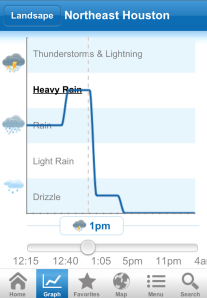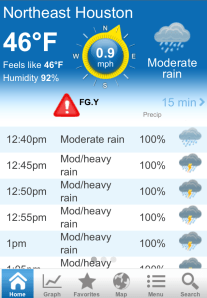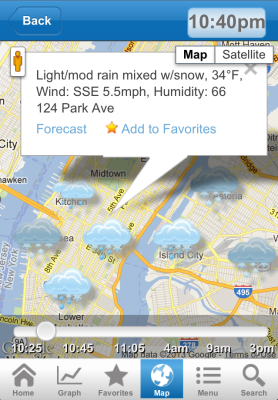While “the weather” generally makes for dependably boring conversation, the weather itself tends to be anything but dependable. Mother Nature is mercurial, and she has no problem raining on your parade at a moment’s notice. When it comes technology and the weather, the conversation (albeit boring) is usually dominated by the usual suspects, like expensive URLs and familiar incumbents, including Weather.com, The Weather Channel and AccuWeather — to name a few. Plus, Google offers realtime weather forecasts in search, and your iPhone and Android device have native weather apps right at your fingertips.
Although gaining mindshare over these incumbents would seem to be a tall order, an Israeli startup called Nooly wants to re-start the conversation — namely by giving everyday weather watchers a more dependable (and localized) weather forecast on the Web and on mobile. The startup has been beta testing early versions of its patented technology for over a year now, but today it officially pulled back the curtain on its ready-to-wear mobile products.
Nooly Founder and CEO Yaron Reich believes that, while people are far from being devoid of options when it comes to weather forecasts, today’s generally available consumer-facing options tend to be anything but dependable, instead relying on information that is frequently general and out-of-date. So, Nooly’s free iOS and Android apps offer instead technology that claims to be able to predict the exact minute a storm will start, get worse and dissipate, while delivering forecasts that are hyperlocal and offer near-realtime granularity.
This means that all of Nooly’s predictions are localized to within 0.4 square miles of your current location and are updated every five minutes. As such, Reich believes that Nooly is the first weather app to offer these features, with a near-perfect degree of accuracy in one mobile product — while featuring its own unique predictions based on its long-developing proprietary algorithms.
Of course, while the topic of weather can be about as boring as conversation can get, it probably doesn’t need to be said, but it also can have a big effect on your plans for your lunch break, your weekend camping trip, what you decide to wear and so on. Nooly, then, wants to deliver the most accurate, localized and up-to-date forecasts out there so that you, reader, can know how Mother Nature plans to impact your life on any given day so that you can plan accordingly.
So what does Nooly offer, you ask?
While it’s not the sexiest app on the design front, Nooly delivers weather predictions for over 20 million locations in the U.S., down to 0.4 square miles from you currently stand. For New York City alone, for example, Nooly offers over 1,500 predictions. The app features a table screen, which includes hourly forecasts, 15 minute forecasts (for the next 60 minutes) and 5-minute forecasts for the coming hour.
Forecasts can be viewed list-style or on a realtime map, including your locations of choice, meaning that users can drop up to six “weather markers” to display the weather in realtime from those locations. Users can drag and drop markers and move the app’s “slider” to see how different weather conditions are forming and behaving at a given location. It also offers a weather prediction chart segmented in five-minute intervals or hourly steps in landscape or portrait mode, along with a search page, wherein users can peruse weather for specific addresses, like restaurants, parks, tourist destinations, etc.
 The app updates its forecasts every five minutes for the entire continental U.S. and Reich says that it’s one of a few “commercially available weather app that makes predictions by tracking and analyzing each cloud above the U.S.” and even bases its predictions off of “every convective cell within a cloud or thunderstorm. The founder says that, until now, this kind of technology has really only been available to government and federal agencies (like the military, the FAA, NASA and the EU Space Agency among others).
The app updates its forecasts every five minutes for the entire continental U.S. and Reich says that it’s one of a few “commercially available weather app that makes predictions by tracking and analyzing each cloud above the U.S.” and even bases its predictions off of “every convective cell within a cloud or thunderstorm. The founder says that, until now, this kind of technology has really only been available to government and federal agencies (like the military, the FAA, NASA and the EU Space Agency among others).
Now, that sounds cool — as does the fact that its algorithms calculate (in realtime) data from over 260 National Oceanic and Atmospheric (NOAA) radars and two NASA satellites — but how the “h-e-double-hockey-stick” does Nooly pull that off?
According to Reich, to advise pilots on severe weather events, the FAA uses an algorithm that tracks every cloud above the U.S., which just so happens to be developed by Nooly’s “Chief Meteorologists,” Professors J.R. Mecikalski and Daniel Rosenfeld of the University of Alabama-Huntsville and the Hebrew University in Jerusalem, respectively.
Nooly’s search and predict tools (for realtime forecasting within a 60-minute timeframe at five minute intervals) are protected by several patents developed by the startup’s Chief Meteorologists, which give it a leg-up on the competition like The Weather Channel and similar offerings from companies like SkyMotion and afford it a little protection from would-be poachers.
As to where Nooly gets its data from: The largest portion of the app’s dataset comes from raw, three-dimensional radar data from the NOAA’s new network of over 260 individual radars. The app supplements that data with realtime satellite data from NOAA and NASA satellites, both for visible and infra-red channels, along with using data from ground stations (for validation) and other numerical models.
All in all, this means that the Nooly algorithms are processing 11,300 MB of meteorological data every hour, resulting in almost three billion predictions for the continental U.S. and Canada alone every hour — or 69 billion predictions each day.
That’s all well and good, but it’s not particularly difficult to make note of the fact that, if Nooly hopes to gain much mindshare in the Weather Market, it has to go up against big names like The Weather Channel. TWC is a highly-recognized name, which makes it easy for people to pick out among the options (and to trust) and has become one of the most-downloaded weather apps as a result.
 To curry favor amidst the brand recognition of The Weather Channels of the world, a startup has to go above and beyond, or else users are just going to stick to familiar territory. But Reich is optimistic based on the fact that it’s not unusual to hear complaints about TWC’s app (and that of others), regarding the accuracy of it’s local weather predictions.
To curry favor amidst the brand recognition of The Weather Channels of the world, a startup has to go above and beyond, or else users are just going to stick to familiar territory. But Reich is optimistic based on the fact that it’s not unusual to hear complaints about TWC’s app (and that of others), regarding the accuracy of it’s local weather predictions.
He attributes this to their reliance on “numerical models,” which are great for predicting the weather a few hours in advance, up to a few days, however, these predictions are statistically accurate only if the location in question is large enough and the time is at least one hour out. It also helps The Weather Channel’s accuracy that (according to its own website), for a prediction to be correct, rain drops don’t even need to hit the ground. (Wah, wah.)
The numerical models in use today, the founder says, are pretty much incapable of predicting the formation of a single cloud and, instead focus on predicting the probability of conditions suitable for cloud formation in a given time (at least one hour) in a relatively large domain. To fight this, he says, companies need to incorporate “nowcasting” — or realtime prediction — that uses algorithms to actually track and make predictions based off data being produced by individual clouds.
This is a tall order and why Nooly has been hard at work on its app for nearly two years. So, while The Weather Channel updates its predictions every hour (and thus its predictions are an hour old when they get updated), Nooly updates its entire prediction set and refreshes every five minutes. That’s where Reich thinks Nooly can win over TWC users and those looking for more accurate, realtime predictions. Although good luck explaining all that to the Average Joe, who just wants to know whether he should bring an umbrella to work or not.
Another big area of opportunity for Nooly could be making its large and not-exactly-standard data set available to other applications and tools that want to offer realtime weather forecasts. One could see this appealing to navigation apps (Waze, anyone?) or social networks, who could use Nooly to showcase weather in a location by way of a “check in” or for scheduling and to-do list apps, which could let their users plan what to wear for their next meeting. As such, the startup is developing an API, which is currently in beta and available to select partners. The startup plans to open up its APIs more publicly later this year.
Being hyperlocal brings with it wide range of challenges,” Nooly’s founder tells us. “We had to adjust our algorithm for different cities, like Seattle, which experiences shallow, constant rain, compared to New York, which often sees bursts of rain lasting a few minutes and impacting only a cluster of city blocks. San Francisco is also a tricky city, with a mostly calm climate, though the weather can change in very specific streets and neighborhoods. Hyperlocal is tough, but it was extremely important for us to get it right so that we can offer a differentiated user experience and solve a few of the biggest pain points in existing options — and planning your day so that you stay can stay dry.
For more, find Nooly at home here.
